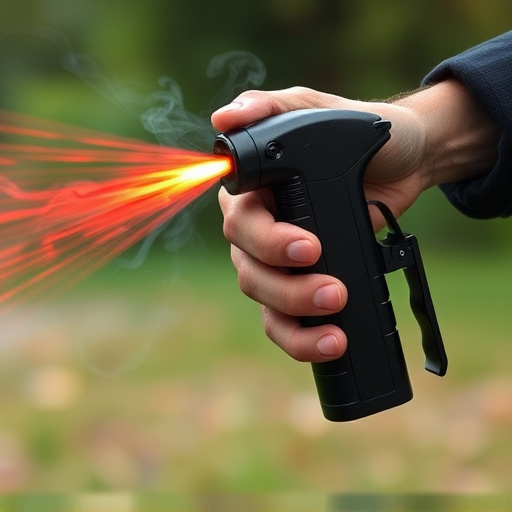The best pepper spray self-defense techniques are vital for both civilians and law enforcement, offering enhanced protection in high-risk situations. For officers, accurate deployment, targeted aiming at the face, and adherence to use-of-force policies are key. Proper training ensures minimal collateral damage and de-escalates tensions. Civilians should focus on simple yet powerful strategies to deter attackers while minimizing risks. Effective use requires a mix of accuracy, safety knowledge, and understanding legal considerations, ensuring responsible deployment without infringing on individual rights.
“In the realm of law enforcement, pepper spray equipment is a critical tool for maintaining public safety. This comprehensive guide delves into the multifaceted world of pepper spray, exploring its uses, effects, and optimal deployment strategies. From understanding the science behind this powerful agent to choosing the right equipment for maximum effectiveness, we offer insights into best practices. Additionally, we dissect legal considerations and provide essential self-defense techniques for both civilians and officers, ensuring preparedness in high-pressure situations. Discover the key to enhancing safety through informed use of pepper spray, especially when it comes to mastering the best pepper spray self-defense techniques.”
- Understanding Pepper Spray: Its Uses and Effects in Law Enforcement
- Choosing the Right Pepper Spray Equipment for Optimal Performance
- Effective Pepper Spray Self-Defense Techniques for Civilians and Officers
- Legal Considerations and Safety Protocols for Pepper Spray Deployment
Understanding Pepper Spray: Its Uses and Effects in Law Enforcement
Pepper spray, also known as oleoresin capsicum (OC) spray, is a powerful tool in law enforcement and self-defense arsenal. It’s a non-lethal substance designed to temporarily incapacitate individuals, providing officers with crucial time to control or subdue suspects. The key active ingredient, capsaicin, is derived from chili peppers, making it an effective irritant that targets the eyes, nose, and respiratory system. When deployed, pepper spray creates a burning sensation, leading to teary eyes, reduced visibility, coughing, and difficulty breathing—effects that usually last between 20 minutes to an hour.
For law enforcement officers, understanding the best pepper spray self-defense techniques is essential for effective use during high-risk situations. Proper training ensures they can deploy the spray accurately while minimizing collateral damage. The right technique can help control aggressive subjects, giving officers a chance to gain custody and de-escalate tensions. By learning proper application methods, such as aiming for the face and maintaining distance, officers can maximize pepper spray’s effectiveness while adhering to their department’s use-of-force policies.
Choosing the Right Pepper Spray Equipment for Optimal Performance
Effective Pepper Spray Self-Defense Techniques for Civilians and Officers
In the realm of self-defense, pepper spray has emerged as a game-changer for both civilians and law enforcement officers alike. When used effectively, it can disable an assailant temporarily, providing precious time to escape or summon help. The best pepper spray self-defense techniques involve understanding how to deploy the spray accurately and safely, while also knowing how to maximize its effectiveness. For civilians, practicing proper aim and learning safe storage methods is paramount; aiming for the face, eyes, and nose ensures maximum impact with minimal risk of misting nearby bystanders.
Officers, on the other hand, must master not only the technical aspects of spray deployment but also de-escalation tactics. By controlling an individual’s behavior through verbal commands and strategic positioning before resorting to pepper spray, officers can ensure their safety and minimize harm to the subject. Additionally, staying up-to-date with training on different types of pepper spray and their unique properties allows both civilians and professionals to choose the best pepper spray self-defense technique for any given situation, enhancing their ability to defend themselves or others effectively.
Legal Considerations and Safety Protocols for Pepper Spray Deployment
When it comes to law enforcement pepper spray equipment, understanding legal considerations and safety protocols is paramount for effective deployment. Before utilizing pepper spray, officers must ensure they operate within the boundaries set by local, state, and federal laws. These regulations dictate when and how pepper spray can be employed, focusing on minimizing harm and respecting civil liberties. For instance, many jurisdictions mandate clear criteria for justifying its use, such as in self-defense or to control violent disturbances.
Safety protocols are equally crucial. Training programs emphasize the need for officers to receive comprehensive instruction on the best pepper spray self-defense techniques, including proper application methods. Officers must also be aware of potential risks and contraindications, like respiratory sensitivities or certain medical conditions that might complicate the situation. Adhering to these safety measures ensures that pepper spray is deployed responsibly, balancing public safety with respect for individual rights.
Pepper spray equipment is a powerful tool in law enforcement, offering a strategic advantage during various situations. By understanding its uses, effects, and legal implications, officers can make informed decisions. Choosing the right gear ensures optimal performance, while learning the best pepper spray self-defense techniques empowers both civilians and officers for effective protection. Navigating these aspects enables responsible deployment, prioritizing safety and minimizing harm.
